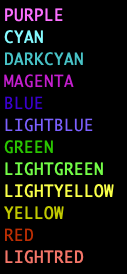Colorize text output

This helper provides developers with a simple class that can be leveraged to add color to terminal text output by providing standard ANSI escape sequences as attributes.
The Color class was first introduced in FalconPy v1.5.1.
Supported colors
This function provides support for the following ANSI colors.

Support for BOLD and UNDERLINE is also provided.
Attributes
This class provides the following attributes.
| Attribute | Returns |
|---|---|
| PURPLE | \033[95m |
| CYAN | \033[96m |
| DARKCYAN | \033[36m |
| MAGENTA | \033[35m |
| BLUE | \033[34m |
| LIGHTBLUE | \033[94m |
| GREEN | \033[32m |
| LIGHTGREEN | \033[92m |
| LIGHTYELLOW | \033[93m |
| YELLOW | \033[33m |
| RED | \033[31m |
| LIGHTRED | \033[91m |
| BOLD | \033[1m |
| UNDERLINE | \033[4m |
| END | \033[0m |
To prevent bleed, END is used to close the colorized text block and should always be provided.
Adding color to text output
Class attributes are returned as strings, meaning they can be interpolated directly into strings intended for terminal output.
Code example
from falconpy import Color
result = f"This string contains {Color.RED}red {Color.BOLD}bold{Color.END} text"
print(result)
Output example



